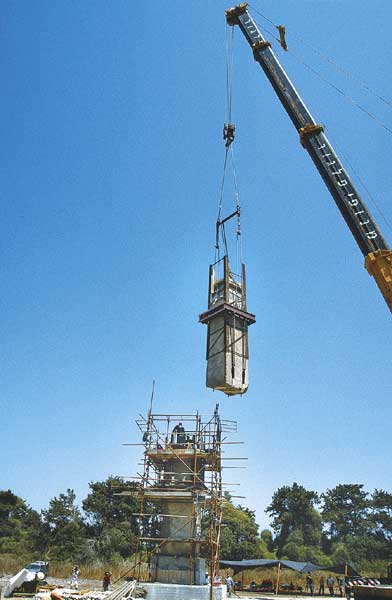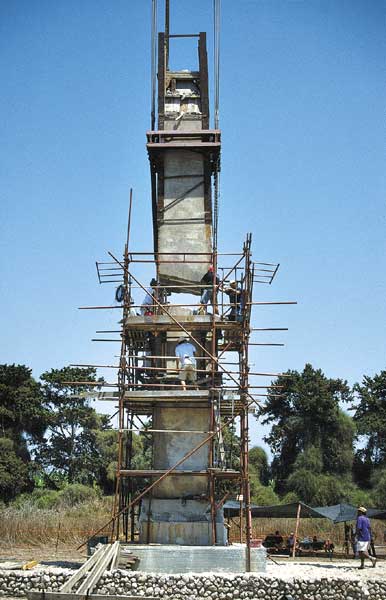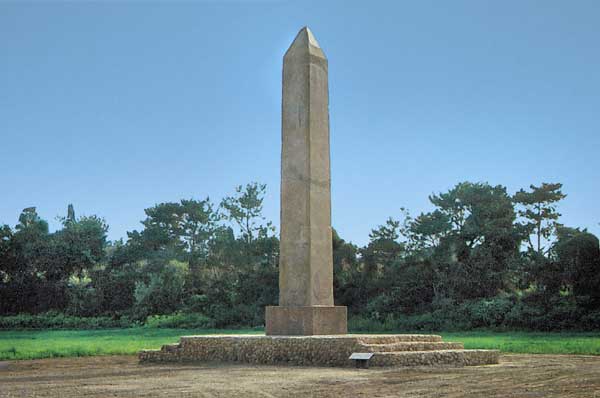Caesarea: Herod and Beyond
Vegas on the Med
A Tour of Caesareas’s Entertainment District
024
024
024
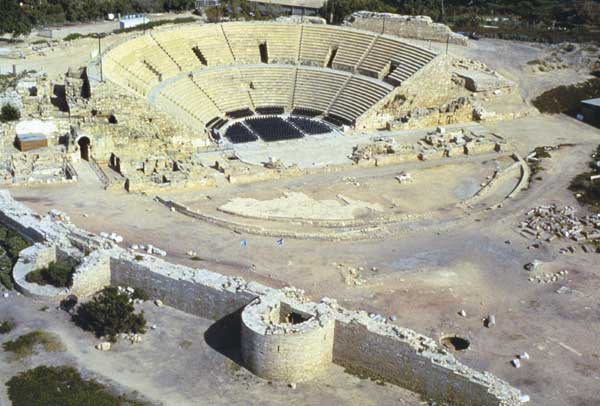
025
What city was the official residence of the Roman prefect after Judea came under direct rule by Rome beginning in 6 C.E.?
What city was designated as capital of the Roman province of Judea after the Romans destroyed Jerusalem in 70 C.E?
What city was the political and economic capital of the country from the institution of the Roman prefecture to the Arab conquest more than 600 years later?
What was the largest and most important city in Judea (called Palestina after Hadrian suppressed the Second Jewish Revolt in 135 C.E.) during the first to the seventh century C.E.?
If you are tempted to answer Jerusalem to any of these questions, you would be wrong.
And the answer to all the questions is the same: Caesarea Maritima.
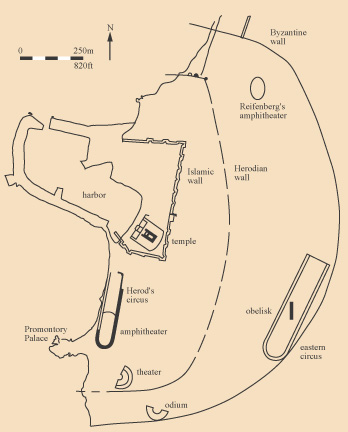
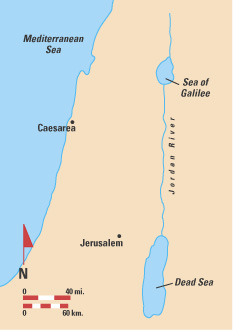
026
Built by Herod the Great to honor his patron Caesar Augustus, Caesarea Maritima (to distinguish it from the inland Caesarea Philippi) was built at the site of a small Hellenistic port called Straton’s Tower, about 25 miles north of modern Tel Aviv. Herod took 12 years to construct Caesarea Maritima (from 22 B.C.E. to 10/9 B.C.E.). Caesarea and the Temple Mount in Jerusalem, which Herod expanded and completely rebuilt, remain the two most ambitious projects of the first-century B.C.E.’s greatest real estate developer (among other things). As two observers have remarked, “In the Herodian state, [Caesarea] was a pagan and Greek counterweight to Jewish Jerusalem.”1
Herod built Caesarea on the plan of a typical Roman city. The city was subdivided into insulae (square city blocks) by a grid of parallel and perpendicular streets located half a stade apart (a stade is about 600 feet). Herod’s city also included a temple dedicated to Augustus and Rome in the center of the city, a palace, a forum (marketplace), a magnificent harbor with a breakwater that would safely accommodate the largest ships and a semicircular wall enclosing the city. Caesarea Maritima soon became the major port of the country.
Naturally, the city also included facilities for public entertainment—theatrical performances, musical offerings, chariot races, athletic contests, gladiator combats, animal shows and the like—some built by Herod and others added later.
Herod built a theater in Jerusalem as well, but only the one in Caesarea has survived.a Herod’s Caesarea theater was repaired many times over the years, and in the second-third century C.E. (during the Severan dynasty [193–235 C.E.]), it was entirely rebuilt. Little of the Herodian theater survived the Severan-period rebuilding, however, and, what little did survive, is buried under the later Imperial theater. The Imperial theater continued in operation until the end of the Byzantine period; after the Arab conquest of 640 C.E., it became part of a large fortress area.2
The Imperial 027theater was first excavated in the 1960s by an Italian team led by Antonio Frova. It is the largest theater ever excavated in Israel.
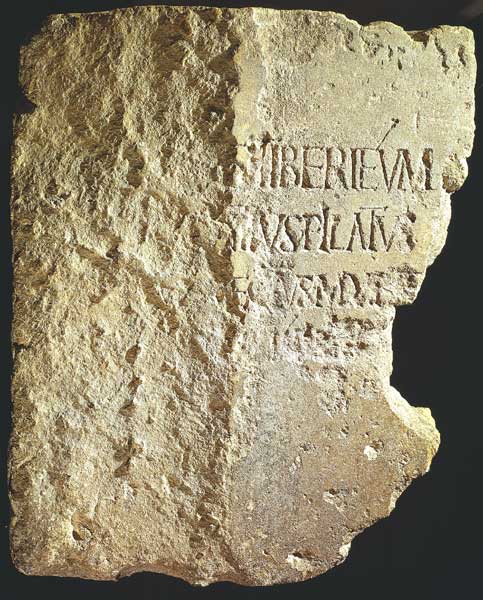
Between 1994 and 2000, I led several rescue excavations in the vicinity of the theater on behalf of the Israel Antiquities Authority.
It was the Italian team, however, who found the famous Pontius Pilate inscription. When the Roman emperor Augustus deposed Herod’s son Archelaus in 6 B.C., Judea was reorganized as a sub-province of the province of Syria and was ruled by a governor called a prefect. Pilate held the office of Prefect of Judea from 26 to 36 C.E. and his official residence was in Caesarea. When the theater was remodeled in the third century C.E., the builders reused a stone plaque with an inscription on it in a small staircase in the new theater. It measures 32 inches by 27 inches. Unfortunately, the beginning of all four lines has been defaced, but enough is there to restore everything but the first word:
“… the Tiberium, which Pontius Pilate, the Prefect of Judea, gave [and] dedicated.”3
This inscription is the only archaeological confirmation of Pilate’s existence. The Tiberium, which is mentioned in the inscription, was a temple erected to the Emperor Tiberias. The inscription also demonstrates that Pilate’s title was Prefect, and not, as so often stated, Procurator.
One of the few elements of the earlier Herodian theater that the excavators did find was the floor of the orchestra below the marble floor of the Imperial theater. The Herodian floor was made of painted plaster. The excavators found 14 successive layers of plaster decorated with colored fish-scale, geometric and floral designs sometimes with imitation of colorful marble or stone floor tiles. The orchestra (the area in front of the proscenium, or stage) is semicircular, as in Roman theaters, rather than round (a full circle), as in earlier Greek theaters.
The floor of the later Imperial theater had a marble opus sectile floor, forming a design of marble slabs. Most of this is gone, however, recycled for construction in the early Islamic period, either as building blocks or burnt in lime kilns.
The semicircular orchestra of the Herodian theater measured 80 feet in diameter. The Imperial remodeling of the theater extended the semicircular orchestra into a large circular basin by the addition of a semicircular area (called the scenae frons) behind the stage. It was used for nautical games.
The Imperial theater had six or seven wedges of stone seats rising high above the orchestra. In the central wedge was a rectangular box, no doubt for the governor. Throughout, 029the carefully fashioned tiers of seats were decorated with fine molded edge carved from hard kurkar stone. Unfortunately, the seats were destroyed in antiquity; only the bases are in situ. However, 26 of the assumed 39 original tiers of seats have now been restored to accommodate modern performances. The Imperial theater could hold more than 5,000 people; six entrance vaults (vomitoria) led into the theater. The theater has been reconstructed in modern times and is again used for performances; today it can hold 3,800 spectators.
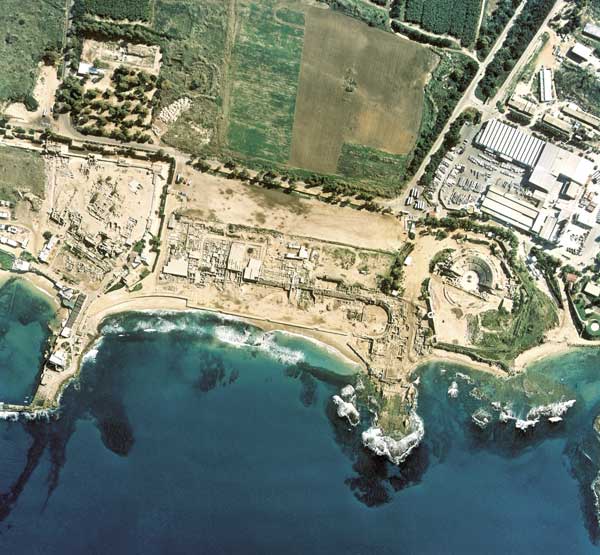
Around the theater is a well-preserved defense wall with semicircular towers. It may seem at first to be a city wall, but it is not. It is the wall of the fortress into which the theater was incorporated in the seventh century. The semicircular towers help us to date it. They contrast with the square towers of the Byzantine city wall.
Herod’s Caesarea also included a circus (the Greeks called it a hippodrome). Excavated by the Israel Antiquities Authority and the Combined Caesarea Expedition, the Caesarea circus was used principally for chariot racing, although it was apparently used for foot races as well. We discovered four lanes in the eastern part of the circus, but there was room for four more (eight was the common number of lanes in a circus). For the chariot races, the chariots were harnessed with either two horses (bigae) or four horses (quadrigae).
Herod’s structure was a typical Roman circus of the Augustan period. It is a long U-shaped structure with starting gates at one end. The arena was nearly 1,000 feet long and roughly 170 feet wide. The seating area had 12 tiers of seats, enough to accommodate 5,000 people. The seats were separated from the arena by a wide and deep dugout.
At the southeast end of the U-shaped circus, a small shrine was quarried into bedrock under the tiers of seats. Such shrines were common in Roman circuses.4 This shrine had two openings with a niche in each one. We found a Greek inscription in the shrine reading “Merismos [the] charioteer.” We also found four marble, human-shaped feet in the shrine; all four are 030right feet. Votive body parts are often found in such shrines. The votives protect the power, energy, might or health of the offerant.


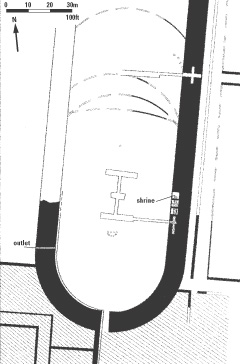
Interestingly enough, above the pagan shrine was a later wall (from the fifth-sixth century) on the plaster of which was etched a person with a halo, fishermen and boats. We suspect, as so often happens, that the religious nature of the site was preserved but transformed to serve the later Christian community.
In the second century C.E. (probably during Hadrian’s reign), a second, larger circus was built for chariot races far to the east of Herod’s circus, a structure now referred to as the eastern circus. Because Herod’s circus was now unoccupied, the southern third was converted to an amphitheater, a structure sometimes referred to in Greek literature as a “double theater.” The amphitheater was a Roman invention designed as a permanent facility for gladiatorial combat and hunting games. The space in Herod’s circus was converted to an amphitheater by a wall across the circus sealing off the southern part of the structure. The wild animals used in combat between humans and beasts would thereby be prevented from escaping. The larger Roman amphitheaters could accommodate an audience of tens of thousands.
The floor of the amphitheater sloped gently from the center to the sides, enclosed by a wall separating the arena from the seats. This wall is called the podium wall. In the amphitheater, the podium wall was plastered and painted with designs of animals and a human image in front of schematic plants. The species include elephant, rhinoceros, leopard, deer, dog or wolf, a member of the equus family (either a horse or a zebra), fox and rabbit. Unfortunately only the lower third of the 031human image has survived. The man, who wears colorful trousers, is probably either an animal trainer or a gladiator. Exposed to the elements, the paintings naturally frequently required maintenance and repair. Three cycles of general repairs were observed over the animal design, including dozens of repaintings and uncounted retouchings. On the first two cycles after the animal paintings, the wall was painted to imitate marble slabs. In the last cycle, the plaster was left unpainted.
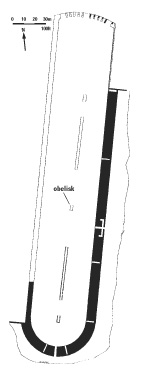
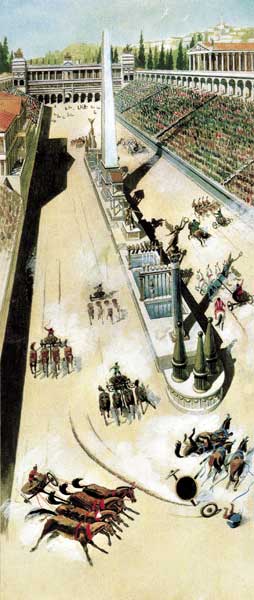
Built outside the Herodian city wall, the U-shaped eastern circus was nearly 1,500 feet long and almost 300 feet wide, compared to Herod’s circus, which was only 1,000 feet long and 170 feet wide. The eastern circus could have held up to 20,000-25,000 spectators, although the exact number is unknown since we do not know how many tiers of seats there may have been.
The eastern circus was first explored by Claude Conder and H.H. Kitchener in the late 19th century. On the surface were three columns made of red granite from Aswan in Egypt, the marble bases of which were found only four years ago. An even more exciting find 032was three pieces of a fallen obelisk that once stood in the center of the arena of the circus. Two pieces of the obelisk that fit together were over 34 feet long. The third piece was a fragment of the pyramid on top of the obelisk. The pyramid would have been nearly 5 feet high. The rest of the obelisk is missing, but a large red granite pedestal that may have been the base was found 200 feet north of the fallen obelisk.
When the Israel Antiquities Authority (IAA) excavated part of the eastern circus between 1996 and 1999, we decided to attempt to re-erect the obelisk. It was a much more complicated project than you might expect. The Egyptian obelisks that were re-erected in ancient Roman and Byzantine circuses were all monoliths. So were the ones re-erected since the 16th century in Rome, London, Paris and New York. The task at Caesarea was more complicated because the re-erected obelisk was broken, with missing segments at the bottom and between the trunk and pyramid on top. The IAA appointed a committee of archaeologists, historians, architects and conservators charged with judging the feasibility and ethics of the project. It took the IAA’s conservation team more than a year to complete the restoration. A special glue, reinforced by titanium bars inserted into holes drilled on both sides of the segments, assured that the restored obelisk would hold together.
Because we weren’t sure that the red granite block was in fact the pedestal of the obelisk, a new concrete pedestal was created. Now the restored obelisk has been re-erected in the center of the arena of the eastern circus. The eastern circus was used for more than 450 years, until the Arab conquest in 640 C.E.
Let’s go back to the amphitheater that was created from Herod’s old circus. Coin evidence indicates that from about the beginning of the fourth century C.E., the amphitheater was no longer used. There must have been another amphitheater to replace it. It has not yet been found, however (only about 4 percent of Caesarea has been excavated).
But there is a pretty good guess as to where this other amphitheater is located. In December 1944 a set of aerial photographs was taken at Caesarea. Studying one of them, Abraham Reifenberg, an Israeli geographer and historian and an engineer by profession, deciphered an oval feature as an oval amphitheater. Reifenberg identified this oval building as the amphitheater mentioned by the first-century Jewish historian Josephus. But the excavation of Herod’s circus, which included an amphitheater, proved Reifenberg’s oval structure was not Josephus’s amphitheater.
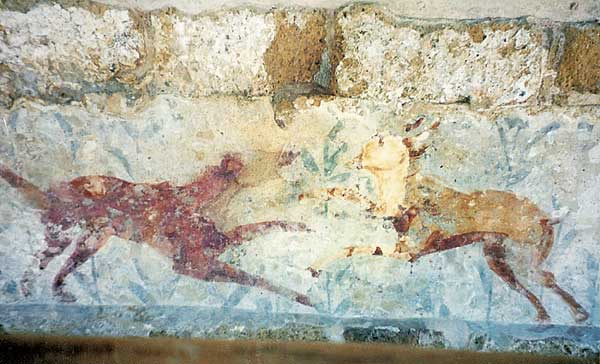

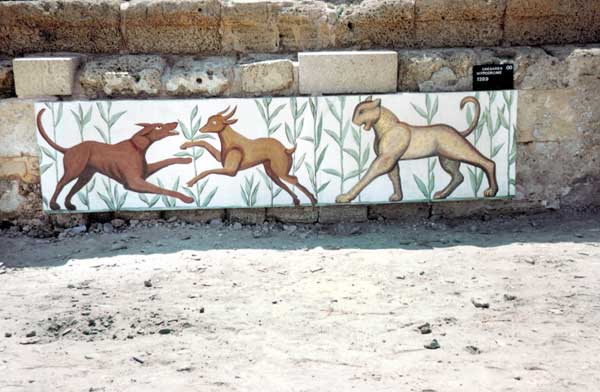
In 1960, an Israeli expedition headed by Avraham Negev failed to find any stone-constructed tiers at Reifenberg’s oval. Nevertheless, Negev recognized that his expedition was not sufficient to disprove Reifenberg’s suggestion of an amphitheater at this location. It would be “appropriate to return and examine this site,” Negev wrote. I believe Reifenberg was right in deciphering this oval as an amphitheater, but he was wrong in identifying 034it as the amphitheater Josephus saw in the first century C.E. If this is a standard Roman amphitheater, it was constructed to replace the amphitheater located in the southern part of Herod’s circus, probably in the third century C.E. Only large-scale excavations at the site, however, will answer the question definitively.
We have mentioned a place for chariot races, for gladiator combats, animal performances and fights, and theatrical performances. To this list, we must add the more elevated activities of poetry recitations and musical offerings. Perhaps it will come as no surprise that in ancient Caesarea, the need for this elevated entertainment could be met in a smaller facility—called an odium. An odium was typically smaller than a theater, allowing for an audience of only a few hundred, and was often roofed. A Byzantine historian named Malalas tells us that the Emperor Vespasian (69–79 C.E.) built “a very large odium [in Caesarea] the size of a large theater using the spoils of the Jewish war [the Jewish revolt against Rome of 66–70 C.E.].”
In a rescue excavation that I directed in 2000–2001, we may have found the Caesarea odium. Unfortunately, it had been largely dismantled in ancient times (and then covered by sand dunes). It was located near the sea about 600 feet southeast of the Imperial theater. The evidence from our excavation indicates that the structure was not built until the second-third century C.E., however—too late for the structure Malalas describes as having been built by Vespasian. But perhaps our evidence is of a later repair and the basic structure did exist in Vespasian’s time? There are several other possibilities. Because of the uncertainties, we have been calling the structure the theater/odium—in case it was simply a second theater unmentioned in the literature. The structure was indeed large, as Malalas had said, but still it was only a little more than half the size of the previously-described Imperial theater to the northwest. 035Because of its current condition, we could not tell archaeologically whether it was roofed or not.
The final structure for public entertainment in Caesarea was the stadium, where athletic contests were held—races by naked athletes, races by athletes wearing full battle equipment, distance jumps, discus throws, wrestling, boxing, etc. But the Caesarea stadium has so far not been found. It was in the stadium in 26 C.E. that, as Josephus tells us, Pontius Pilate gathered the Jews who protested against the attempt to admit the signia of the Roman army into Jerusalem. Once the Jews were inside the stadium, Pilate balked at massacring them and acceded to their demands. It was also in the stadium that Christian martyrs were killed by wild beasts for refusing to offer sacrifices to the Roman gods during the early years of the fourth century, in what is known as Great Persecution (the event was recorded by Eusebius, the fourth-century bishop of Caesarea [bishop from c. 315–339]).
After Hadrian suppressed the Second Jewish Revolt against Rome (132–135 C.E.), the name of the province of Judea was changed to Palestina (Jerusalem had been renamed Aelia Capitolina a few years earlier). Throughout its history, however, Caesarea was a Roman city, with all appropriate facilities for public entertainment. Josephus described the joyous inauguration of Herod’s city, which included “a contest in music and athletic exercises, a great number of gladiators and wild beasts, and also horse races and very lavish shows.” If this was true of Herod’s city, it was equally true during the reign of his successors and during the Roman and Byzantine periods, when the city was capital of Palestina. Over a span of nearly eight centuries, Caesarea reigned as the cultural center of the country.
024 025 What city was the official residence of the Roman prefect after Judea came under direct rule by Rome beginning in 6 C.E.? What city was designated as capital of the Roman province of Judea after the Romans destroyed Jerusalem in 70 C.E? What city was the political and economic capital of the country from the institution of the Roman prefecture to the Arab conquest more than 600 years later? What was the largest and most important city in Judea (called Palestina after Hadrian suppressed the Second Jewish Revolt in 135 C.E.) during the first to the […]
You have already read your free article for this month. Please join the BAS Library or become an All Access member of BAS to gain full access to this article and so much more.
Already a library member? Log in here.
Institution user? Log in with your IP address or Username
Footnotes
But see Ronny Reich and Ya‘akov Billig, “Triple Play: The Many Lives of Jerusalem’s Building Blocks,” BAR, September/October 2002.
Endnotes
Kenneth G. Holum and Avner Raban, “Caesarea,” in The New Encyclopedia of Archaeological Excavations in the Holy Land (Israel Exploration Society, 1993).
The fortress extended west as far as the seashore. The Italian excavators concluded that the conversion to a fortress occurred in the sixth century under the Emperor Justinian. In one of our rescue excavations, however, we found the fortress wall had incorporated earlier walls whose foundation-trenches runs over fill that led into a drain channel of a Byzantine latrine. The fill included many pottery fragments from the sixth-seventh century. Therefore these walls must be dated later than suggested by the Italian excavators. Since Islamic records mention the fortification of Caesarea after the 640 C.E. Arab conquest, we suggest that the fortress was the seat of the Arab/Islamic garrison. The architecture of the fortress fortification—a solid wall with semi-circular towers—is appropriate for early Islamic fortifications rather than Persian or Byzantine fortifications.
See P. Kyle McCarter, Ancient Inscriptions (Washington, DC: Biblical Archaeology Society, 1996), pp. 133–134.


